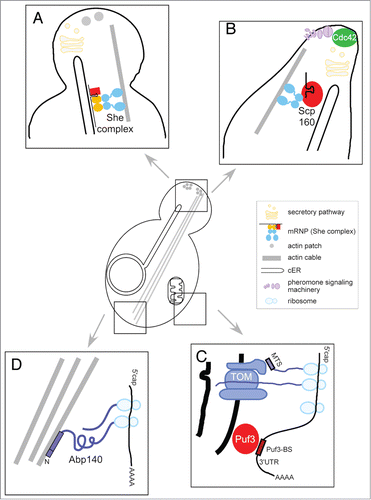Figures & data
Figure 1. (A) Bud-directed mRNA transport occurs simultaneously with ER inheritance. During polarized growth, POL mRNAs targeting and local translation contribute to POL protein deposition within the emerging bud. This mRNP targeting correlates with cER inheritance and depends on SHE1–5, the secretory pathway and a polarized actin cytoskeleton. (B) Shmoo-directed mRNPs use Scp160p and Myo4p for asymmetric targeting. During mating, targeted mRNA transport is mediated by Scp160p, a 14 KH-domain protein that associates with ER and Myo4p. The pheromone-induced RNA-binding of Scp160p is relevant for cell polarization, chemotropism and mating efficiency. Polarized localization of some POL factors, like Cdc42p, likely occurs via secretion. (C) Pre- and co-translational targeting of mRNAs encoding mitochondrial proteins (mMPs). Targeting of mMPs to the outer mitochondrial membrane and the TOM complex likely combines at least two mechanisms: recognition of a signal within the proximal region of the 3′-UTR recognized by the RNA-binding protein Puf3p and active translation of the peptide sequence including the mitochondrial targeting sequence (MTS). (D) Co-translational targeting of ABP140 RNA to the distal pole of the mother cell via actin retrograde flow. Asymmetric ABP140 mRNA localization requires active translation of Abp140p and tethering the nascent chain of Abp140p to actin cables via its N-terminal actin-binding domain (ABD) and a subsequent amino acid stretch.

